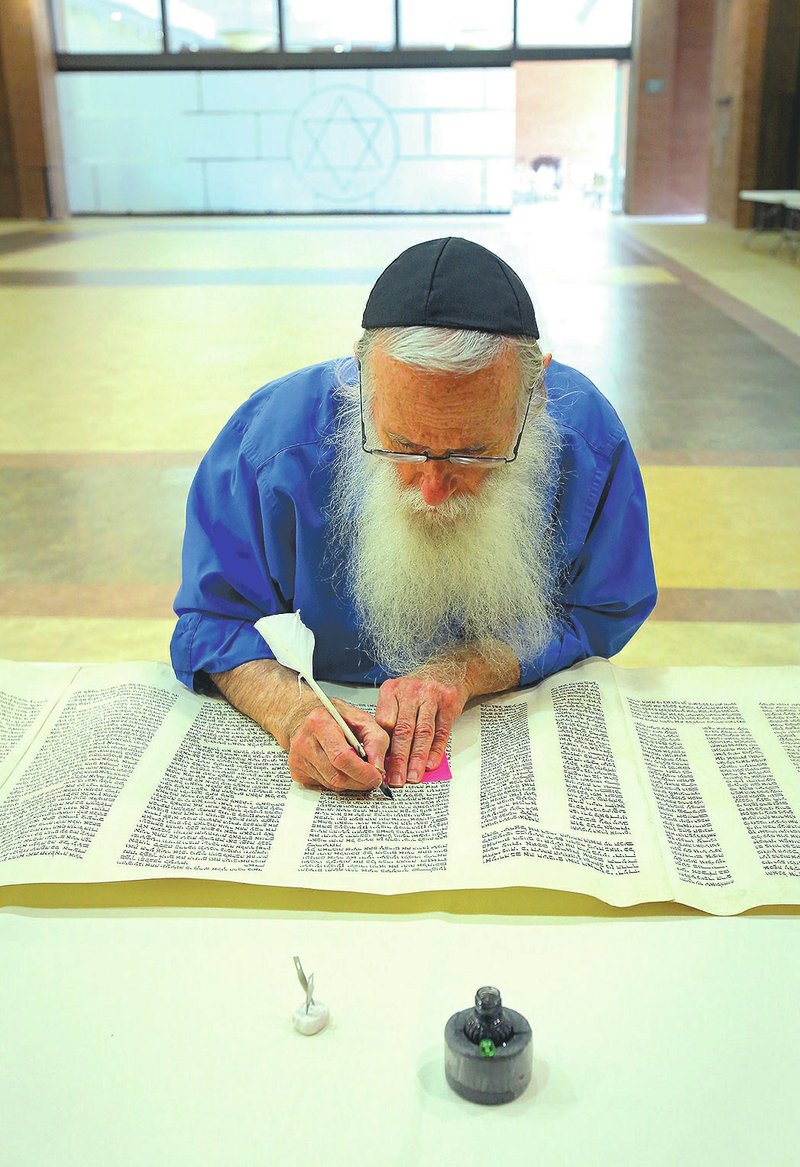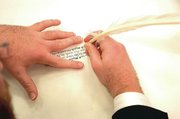"The Torah reveals a beautiful way to aspire to and live a life of holiness through the various religious observances, ethical standards of conduct and justice, and the bounds of a civil society that God reveals in the Torah's words," said Rabbi Robert Lennick, spiritual leader of Congregation Etz Chaim in Bentonville.
The congregation initiates Project 613 on Sunday afternoon. Members of the entire Northwest Arkansas community will work together to restore a Torah scroll damaged by the Nazis in World War II.
Project 613
Torah Restoration
Who: Congregation Etz Chaim
What: Kickoff event
When: 2 p.m. Sunday
Where: First Christian Church, Waterway campus, 4074 Arkansas 112, Bentonville
Information: 464-8001, etzchaimnwa.org
Covenant
The Torah, the first five books of the Bible for Jews, Christians and Muslims, begins with God's creation of the world and ends with the death of Moses, Lennick explained.
"Along the way, the Jews enter into a covenant with God initiated with Abraham and passed down to his son and grandson, Isaac and Jacob. Jacob's descendants, the Israelites, endure 400 years of Egyptian slavery; witness God's liberating power in their Exodus from Egypt; wander, wonder, question, rebel and re-affirm their faith many times; then receive God's incarnation of the law on Mount Sinai," Lennick said. "God gives to Moses the Ten Commandments, and -- we are taught -- God also dictates to Moses the words of the first Torah scroll ever written. Moses brings these back to the people, and, at that point, this former group of slaves begins the evolution to be a 'Holy nation, a Kingdom of Priests.'"
The Torah reveals more than just 10 commandments, said Rabbi Moshe Druin of Sofer on Site, the organization that provided the document for restoration. "It gives 613 pathways (or commandments) telling us how to interact with the world. Godly goodness," he said.
Druin compared the Torah to a modern-day cellphone. "You really believe you will hear the other person talking, so you put it to your ear. But you don't know how it works."
Restoring Souls
The craft of the sofer (or scribe) "is a continual stream of golden string that goes back thousands and thousands of years," said Druin, who will be the scribe for Project 613.
"You've got to come and see. We're doing the same thing that's been done for 2,000 to 3,000 years, when a pen is not a pen and ink is not ink. When a Torah is restored, an ancient document is kept alive."
Sofer on Site also acts as a sort-of clearing house. Some still scribe Torahs, and others are computer printed on parchment, Druin explained. But the organization works to recover ancient copies of the Torah from private individuals and even Jewish congregations that are closing as the population in a geographic area declines.
"They want to try to keep it alive in another congregation," Druin said. "They want to see it grow. They send it out as if it were a child."
Druin's job goes beyond scribing the Hebrew letters of the Torah. He teaches the congregation, the community, how to embrace the Torah chosen for them and "not just let it lie there.
"It's a slow learning process, like having a new child. They have to 'adopt' the Torah. They have to love and take care of their Torah."
Building community
Lennick arrived in Northwest Arkansas nearly a year ago to guide Congregation Etz Chaim, currently in its 11th year. Through Project 613, Lennick wants the congregation to come together "to feel close to the tradition and give them a purpose to repair the world around them -- which is what Jewish people are called to do."
Lennick also wants to focus on the continuity between generations to make the world a better place. "No one's going to repair the world for us," he said.
Project 613 also includes lessons for the community to act as a whole, as told through the Holocaust.
"Don't just accept what's going on -- like the Holocaust or the terror currently caused by the Islamic State," Lennick said.
The Torah scroll coming to the Bentonville congregation has been traced -- through its style of calligraphy -- to Czechoslovakia, near Prague, Lennick said. "I know for sure it's 200 years old," he said.
As the Nazis overtook Jewish villages during World War II, they confiscated the Torahs for a "Museum of an Extinct Race," planned by Adolph Hitler, chancellor of Germany from 1933 to 1945 and leader of Nazi Germany.
But some scrolls were hidden away by members of the local communities. "I think this one was rescued," Lennick said. "In some small village, some righteous person or some courageous person saved the scroll for the synagogue."
From there, Lennick thinks the scroll passed through many private hands before it was given to a synagogue in Florida. Then Sofer on Site obtained the ancient document.
"We felt this (historic story) just added so many important levels of meaning to this project," Lennick said. "Hitler's goal was to reduce the Jewish people to ashes -- which is what they did in the death camps and the woods throughout Germany."
And restoring this Torah symbolically restores the lives of those who perished, both rabbis agreed.
"By restoring this ancient document, you are keeping it alive," Druin said. "And just like the victims of the Holocaust, everyone who signs the Torah receives new life in the community."
"It's a way that everybody can participate, and our community can become a living symbol of what it means to stand up to hate -- in all forms, in all generations, in all times," Lennick said.
"Bringing the scroll back to life -- pulled almost literally out of the ashes -- declares the whole community stands against hate, violence, racism, prejudice and all forms of oppression," he continued. "It's very powerful."
Leaving a mark
Members of Etz Chaim and the entire Northwest Arkansas community are eligible to help restore this ancient piece. For a donation to the congregation, a single person can make an appointment for a private 10 minutes with the scribe. Each can write a single letter, or families and other groups can write entire passages, Lennick said.
"People will say, 'I don't know how to do it,' but the scribe (Druin) will write it with you," Lennick said.
"In Jewish tradition, the 12 tribes came from one family, and we are all part of that family," Druin noted.
"I give you instruction," he continued. "I show you where the letter is supposed to be, and make sure you don't miss it. You can drive the car, but you're not alone. You have to believe you are doing it.
"And you can ask me anything you want," he added.
Druin hopes the experience of writing the Torah is a "unique experience, not a symbolic act."
He told the story of one man, who picked up the writing instrument and broke down in tears. The man had secured high-level deals and had more money than the bank, Druin said. The man was "comfortable and capable and was really awesome."
But yet, the meaning of the Torah touched him, made him believe writing the Torah was something of which he wasn't capable.
The Torah is special, Druin continued. "Many people put clothes on their Torahs, put crowns on their Torahs. They build apartments around them -- they build mansions around them."
But the scroll will remain as original as possible, with only the damaged parts being restored. "If it ain't broke, don't fix it," Druin said.
Druin explained the damage to the Torah might be just one piece of one letter. "But it's the nature of the Torah that if one piece of one Torah is damaged, it can be read, but it doesn't work."
Yet, he said, "Who reads letters? Children read letters. We read words and phrases and columns. It's not the Hebrew ABCs.
"I tell people I am a doctor of letters," Druin continued. "A Torah is healthy when it's whole. If it's not whole, the Torah is ill.
"But it's not the book that has the meaning," Druin said. "This thing is still hanging around after thousands of years and is very strong."
Once completely repaired, the Torah will be used in regular worship in the synagogue at Etz Chaim, Lennick said. "It also can be shown and studied in the community. It is considered a community scroll," he said.
"For those of us who have a signature, those who have written a letter, it's a scroll of us. And it's a scroll of those who have died."
NAN Religion on 08/29/2015


